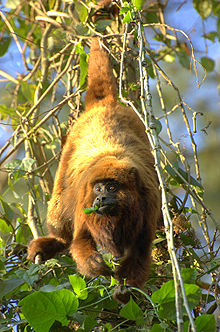
The harpy eagle is a large neotropical species of eagle. It is also called the American harpy eagle to distinguish it from the Papuan eagle, which is sometimes known as the New Guinea harpy eagle or Papuan harpy eagle. It is the largest and most powerful bird of prey found throughout its range, and among the largest extant species of eagles in the world. It usually inhabits tropical lowland rainforests in the upper (emergent) canopy layer. Destruction of its natural habitat has caused it to vanish from many parts of its former range, and it is nearly extirpated from much of Central America. In Brazil, the harpy eagle is also known as royal-hawk. The genus Harpia, together with Harpyopsis, Macheiramphus and Morphnus, form the subfamily Harpiinae.

Howler monkeys are the most widespread primate genus in the Neotropics and are among the largest of the platyrrhines along with the muriquis (Brachyteles), the spider monkeys (Ateles) and woolly monkeys (Lagotrix). The monkeys are native to South and Central American forests. They are famous for their loud howls, which can be heard up to three miles away through dense rain forest. Fifteen species are recognized. Previously classified in the family Cebidae, they are now placed in the family Atelidae. They are primarily folivores but also significant frugivores, acting as seed dispersal agents through their digestive system and their locomotion. Threats include human predation, habitat destruction, illegal wildlife trade, and capture for pets or zoo animals.

The Atelidae are one of the five families of New World monkeys now recognised. It was formerly included in the family Cebidae. Atelids are generally larger monkeys; the family includes the howler, spider, woolly, and woolly spider monkeys. They are found throughout the forested regions of Central and South America, from Mexico to northern Argentina.
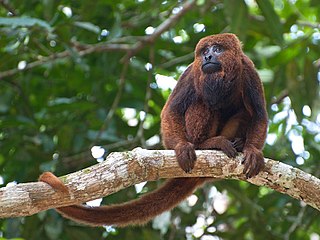
The brown howler, also known as brown howler monkey, is a species of howler monkey, a type of New World monkey that lives in forests in southeastern Brazil and far northeastern Argentina (Misiones). It lives in groups of two to 11 individuals. Despite the name "brown howler", it is notably variable in colour, with some individuals appearing largely reddish-orange or black.

The black howler or black-and-gold howler, is among the largest New World monkeys and a member of the Alouatta genus. The black howler is distributed in areas of South America such as Paraguay, southern Brazil, eastern Bolivia, northern Argentina, and Uruguay. This species is sexually dimorphic, with adult males having entirely black fur and adult females and babies of both sexes having an overall golden colouring; which emphasizes black-and-gold in the name. The IUCN Red List has classed the black howler as Near Threatened as a result of a recent population reduction due to a variety of human-caused factors.

The red-handed howler is a vulnerable species of howler monkey, a type of New World monkey. It is endemic to Brazil, found in the southeastern Amazon and disjunctly in the Atlantic Forest between Rio Grande do Norte and Sergipe.
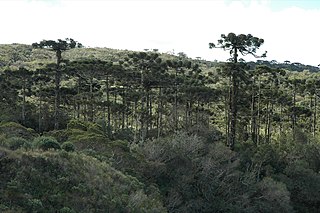
The Araucaria moist forests, officially classified as mixed ombrophilous forest in Brazil, are a montane subtropical moist forest ecoregion. The forest ecosystem is located in southern Brazil and northeastern Argentina. The ecoregion is a southern portion of the Atlantic Forest. The ecoregion also includes select areas of open field called "campos de cima da serra" or "coxilhas".
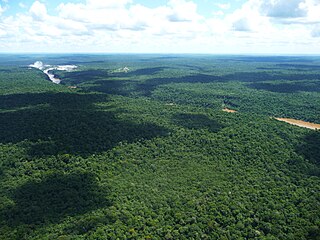
The Alto Paraná Atlantic forests, also known as the Paraná-Paraíba interior forests, is an ecoregion of the tropical moist forests biome, and the South American Atlantic Forest biome. It is located in southern Brazil, northeastern Argentina, and eastern Paraguay.

Dyckia is a genus of plants in the family Bromeliaceae, subfamily Pitcairnioideae.

Oxypetalum is a genus of flowering plants in the family Apocynaceae, first described with this name in 1810. The genus is native to South America.

Serra Geral National Park is a national park in the states of Rio Grande do Sul and Santa Catarina, Brazil.

Sooretama Biological Reserve (Portuguese: Reserva Biológica de Sooretama is a biological reserve in the state of Espírito Santo, Brazil.
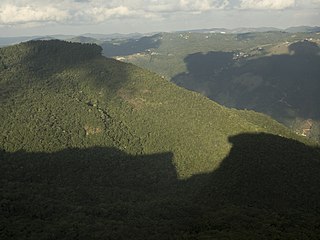
Serra da Mantiqueira Environmental Protection Area (Portuguese: Área de Proteção Ambiental da Serra da Mantiqueira is a protected area of Brazil that includes parts of the states of Minas Gerais, Rio de Janeiro and São Paulo.

The northern brown howler is the type subspecies of the brown howler, native to Brazil. It is listed as critically endangered, with fewer than 250 individuals restricted to the vicinity of the Jequitinhonha River. The species feeds on fruits, flowers, and by preference immature leaves which are easier to digest than mature leaves; foraging for these foods in hillside habitats was shown to require more energy expenditure than in valley habitats.

The Private Reserve of Natural Heritage (RPPN) of University of Santa Cruz do Sul (Unisc) is a protected area created in 2009, through Ordinance nº 16, of March 18, having an area of 221,39 hectares, being nowadays one of the largest protected area of this category (RPPN) in Rio Grande do Sul state, Brazil. This preservation area is within the Atlantic Forest Biome and the predominant vegetation is the seasonal deciduous forest.
The Mata do Passarinho Reserve is an Atlantic Forest nature reserve in the Brazilian states of Minas Gerais and Bahia. The reserve is the last known area to contain Stresemann's bristlefront, a bird which is endemic to Brazil and listed as critically endangered by the International Union for Conservation of Nature (IUCN).
The Bom Jesus Biological Reserve is a biological reserve in the state of Paraná, Brazil.

Serra do Gandarela National Park is a national park in the state of Minas Gerais, Brazil. It protects a mountainous region holding a remnant of Atlantic Forest that is an important source of water for the city of Belo Horizonte.

The Nova Baden State Park is a state park in the state of Minas Gerais, Brazil. It protects a rugged, forested area that is home to several rare or endangered species of mammals.
